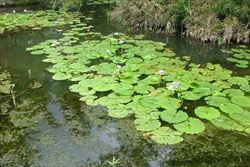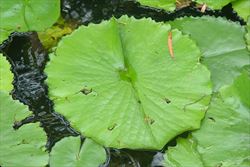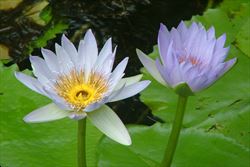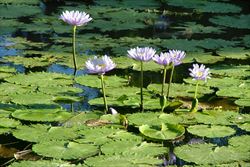Click on images to enlarge

infestation (Photo: Sheldon Navie)

habit (Photo: Sheldon Navie)

leaves and blue flowers (Photo: Sheldon Navie)

leaf with toothed margins (Photo: Sheldon Navie)

variation in flower colour (Photo: Sheldon Navie)

close-up of flowers, showing the petal-coloured tips on the outer stamens (Photo: Sheldon Navie)

close-up of seeds (Photo: Jose Hernandez at USDA PLANTS Database)

the very similar native giant waterlily, Nymphaea gigantea (Photo: Sheldon Navie)

a giant waterlily (Nymphaea gigantea) flower, with entirely yellow stamens (Photo: Sheldon Navie)
Scientific Name
Nymphaea caerulea Savigny
Synonyms
Nymphaea caerulea Savigny subsp. zanzibarensis (Casp.) S.W.L. Jacobs (misapplied)Nymphaea capensis Thunb.Nymphaea capensis Thunb. var. zanzibarensis (Casp.) Conard (misapplied)Nymphaea coerulea F. Muell., orth. var.Nymphaea nouchali Burm. f. var. zanzibarensis (Casp.) Verdc. (misapplied)
Family
Nymphaeaceae
Common Names
blue Egyptian lotus, blue lotus, blue water lily, blue waterlily, Cape blue water lily, Cape blue water-lily, Cape blue waterlily, Cape water lily, Cape waterlily, Egyptian lotus, lotus lily, royal purple waterlily, water lily
Origin
Native to north-eastern, eastern and southern Africa (i.e. Egypt, Eritrea, northern Ethiopia, Somalia, Sudan, Kenya, Tanzania, Uganda, Zaire, Angola, Malawi, Mozambique, Zambia, Zimbabwe, Botswana, Namibia and South Africa) and some parts of south-western Asia.
Naturalised Distribution
Widely naturalised in the coastal districts of eastern Australia (i.e. in south-eastern and central Queensland and in northern and central New South Wales).
Also naturalised overseas in Argentina, south-eastern Brazil and on several Pacific islands (i.e. the Cook Islands, Fiji, French Polynesia and Hawaii).
Notes
Cape blue waterlily (Nymphaea caerulea) is regarded as an environmental weed in Queensland and New South Wales. This widely grown aquatic plant has escaped cultivation and become a weed of freshwater habitats (i.e. dams, ponds, lakes, lagoons, wetlands, and slow-moving waterways), where it displaces similar native species.
Note: The name Nymphaea caerulea subsp. zanzibarensis has been applied to Australian naturalised populations of this species, however it is now believed that this sub-species is only present in cultivation in Australia.

